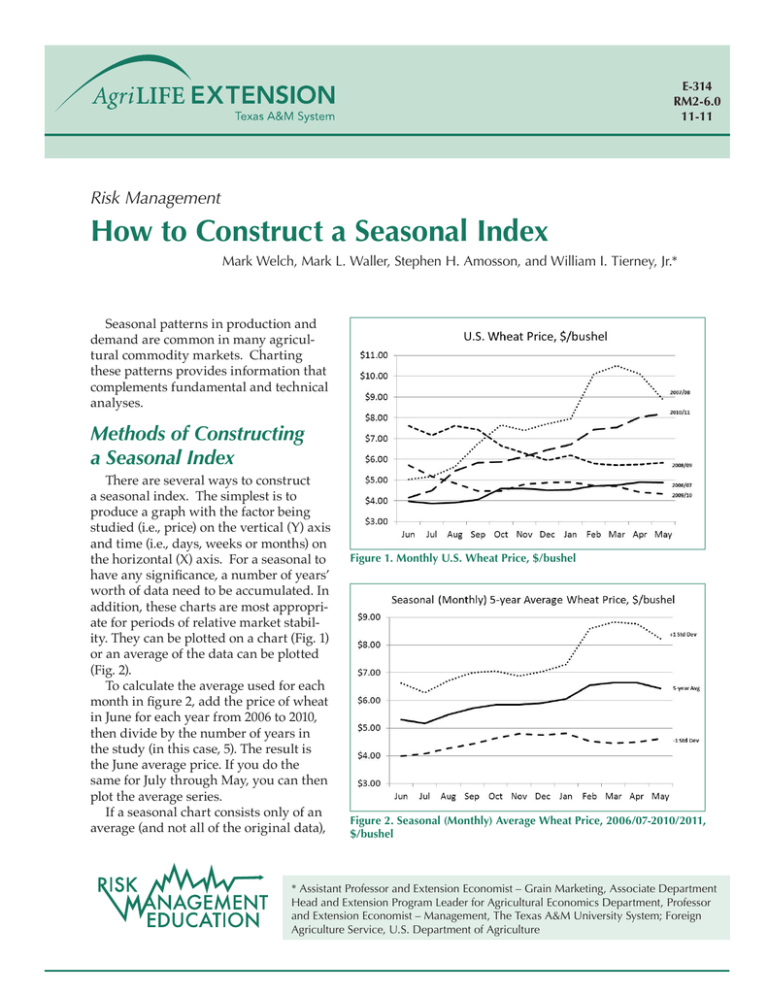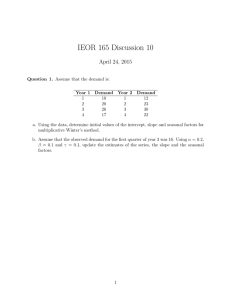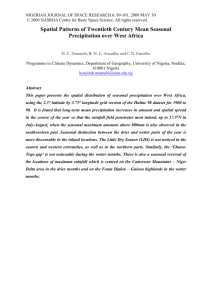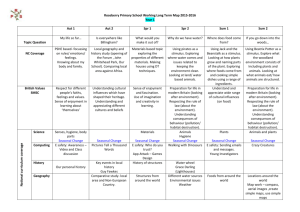How to Construct a Seasonal Index Risk Management
advertisement

E-314 RM2-6.0 11-11 Risk Management How to Construct a Seasonal Index Mark Welch, Mark L. Waller, Stephen H. Amosson, and William I. Tierney, Jr.* Seasonal patterns in production and demand are common in many agricultural commodity markets. Charting these patterns provides information that complements fundamental and technical analyses. Methods of Constructing a Seasonal Index There are several ways to construct a seasonal index. The simplest is to produce a graph with the factor being studied (i.e., price) on the vertical (Y) axis and time (i.e., days, weeks or months) on the horizontal (X) axis. For a seasonal to have any significance, a number of years’ worth of data need to be accumulated. In addition, these charts are most appropriate for periods of relative market stability. They can be plotted on a chart (Fig. 1) or an average of the data can be plotted (Fig. 2). To calculate the average used for each month in figure 2, add the price of wheat in June for each year from 2006 to 2010, then divide by the number of years in the study (in this case, 5). The result is the June average price. If you do the same for July through May, you can then plot the average series. If a seasonal chart consists only of an average (and not all of the original data), Figure 1. Monthly U.S. Wheat Price, $/bushel Figure 2. Seasonal (Monthly) Average Wheat Price, 2006/07-2010/2011, $/bushel * Assistant Professor and Extension Economist – Grain Marketing, Associate Department Head and Extension Program Leader for Agricultural Economics Department, Professor and Extension Economist – Management, The Texas A&M University System; Foreign Agriculture Service, U.S. Department of Agriculture This method dampens the variability that may occur from combining data from years with high annual prices with periods of low annual prices, because what it focuses on is the relative movement of prices within the season. These intra-seasonal price movements are more likely to be uniform whether annual average prices were $3.00 or $8.00 a bushel. To calculate the index in Figure 3, begin by calculating the June price index for each year of interest. June wheat price in 2006 ÷ 2006/2007 marketing year annual price*100. Repeat this procedure for the years 2007 to 2010. The average of all the June wheat price indices is the June index value for the 5 year study. Repeat these steps for July through May. A conditioned or segmented seasonal index can be constructed using only years in which a similar feature was exhibited (i.e., one index for normal crop years and another for short crop years). Using a conditioned index may give a better indication of the seasonal behavior that is likely to occur in a particular year than averaging all years together. A variation on the seasonal index is to attach a second vertical (or Y axis) to the seasonal index and plot this year’s values. Depending on how this axis is scaled, superimposing this year’s actual prices over the seasonal index can quickly reveal whether this year’s price movements are conforming to the expected seasonal pattern (Fig. 4). Figure 3. Seasonal Price Index for Wheat, 2006/07-2010/2011 it is often accompanied by a plotted confidence interval of plus or minus one standard deviation. The standard deviation is a measure of the variability of the historical data from the calculated average. It is useful for showing how reliable the average may be as an indicator of the expected price in a particular year. If the standard deviation is large, the average is not a very dependable indicator of prices; however, if it is small, it is reasonable to place more confidence in the average as a forecasting tool. If you put all of your data in a spreadsheet such as Excel, the software will usually provide formula keys that will calculate the averages and standard deviations for you. Another technique is to construct a seasonal index (Fig. 3). The base or denominator for the index is generally the average for the time period being examined (such as the marketing year). Consequently, each time period’s price (or other factor, such as exports) is expressed as a percentage of the season’s average and will have a value equal to, greater than, or less than 100. Most indices of this type use a base value of 100 percent. A value of 85 (or .85) for a particular period (say the month of June for wheat prices) would mean that period’s wheat price was 15 percent below that year’s 12-month marketing year average price. Conversely, if the February index value was 115 that would mean that February’s price was 15 percent above the marketing year average price. Figure 4. July 2011 Kansas City Wheat Futures and the 5-year Wheat Seasonal Price Index 2 price average index has more slope due to the influence of the uptrend in wheat prices from 2006 to 2010. For more information on how to construct the moving average seasonal index see Agricultural Price and Commodity Market Analysis by John N. Ferris. Seasonals can be constructed to analyze components of crop supply/demand as well as crop prices. For wheat, one of the most influential elements of demand is exports; on average, exports comprise about 50 percent of total wheat disappearance. While wheat exports are shipped on a relatively steady schedule from U.S. ports, wheat export sales commitments (new sales less cancellations) are not so steady. Figure 5. Seasonal Price Index: Simple Average and Moving Average Figure 6 is a five year seasonal index of Methods the monthly proportion of marketing year One problem with using the annual average price wheat export sales. If there was no seasonal nature as a base for calculating a seasonal index is that this in export sales, the average line would be flat at .0833 method misses any trend factors that may be affectfor each month. However, as Figure 6 demonstrates, ing prices. This can limit the usefulness of seasonabout half of U.S. export sales occur in the first four als in periods of significant upward or downward months of the marketing year (June through Septemtrends. Consequently, some seasonal indices are con- ber). structed using a 12-month moving average (Fig. 5). Given that assumption, it is clear when comparing To explain the development of an index based the June and July 2011/12 marketing year commiton a centered moving average would require more ments to the seasonal index that wheat export comspace than is available in this publication, but figure mitments have fallen well below the level one would 5 demonstrates the differences in the indices. The expect if the market was to achieve the projection for basic shape of the index lines is the same but the detotal annual exports. This might suggest that if comtrended moving average index is flatter. The simple mitments don’t increase, USDA may need to lower its export forecast for the year. Seasonals also can help in analyzing other aspects of crop prices such as basis, intercommodity spreads (corn vs. milo), intramarket spreads, option volatility, etc. While many of the graphs shown in this publication use cash prices, it is important to understand that seasonal indices also can be generated using futures prices. Given the anticipatory nature of futures prices, seasonals for futures prices are generally somewhat different than seasonals for cash prices. In addition to harvest, the seasonality of contracts can be influenced by other events such as planting intentions and tasseling (corn). If you are using futures and options as forward pricing Figure 6. Proportional Monthly Wheat Export Sales Commitments, 5-year tools, it will be beneficial to investigate Seasonal Index (2006/07-2010/11) their seasonal behavior as well. 3 Summary For many of the principal field crops grown in the U.S., seasonality is often the dominant factor influencing crop prices within a single production period (usually 12 months). Intra-seasonal variations in supply/demand fundamentals also have an important influence on the pattern that is followed by crop prices (as well as basis, spreads, and options volatility). Using the appropriate seasonal as a guide, a crop producer should have a better chance to correctly identify both the timing of major market moves as well as absolute price levels. Thus, seasonals can help a producer time pre-harvest sales as well as assess the prospects for profitable post-harvest strategies. It is unwise, however, to rely exclusively on seasonals when making crop marketing decisions. For one thing, seasonals are based on past prices and may merely reflect random effects rather than any true predisposition in market performance. Also, even if seasonal patterns are well founded and appear to be statistically reliable, seasonal effects can be overwhelmed by changing fundamental (and even technical) factors. References Ferris, John N. “Agricultural Price and Commodity Market Analysis.” W.C.B. McGraw-Hill, 1998. Schwager, Jack D. “A Complete Guide to the Futures Markets”, 1984. Partial funding support has been provided by the Texas Corn Producers, Texas Farm Bureau, and Cotton Inc.–Texas State Support Committee. Produced by Texas A&M AgriLife Communications Extension publications can be found on the Web at AgriLifeBookstore.org Visit the Texas AgriLife Extension Service at AgriLifeExtension.tamu.edu Educational programs of the Texas AgriLife Extension Service are open to all people without regard to race, color, sex, disability, religion, age, or national origin. Issued in furtherance of Cooperative Extension Work in Agriculture and Home Economics, Acts of Congress of May 8, 1914, as amended, and June 30, 1914, in cooperation with the United States Department of Agriculture. Edward G. Smith, Director, Texas AgriLife Extension Service, The Texas A&M System. Revision







